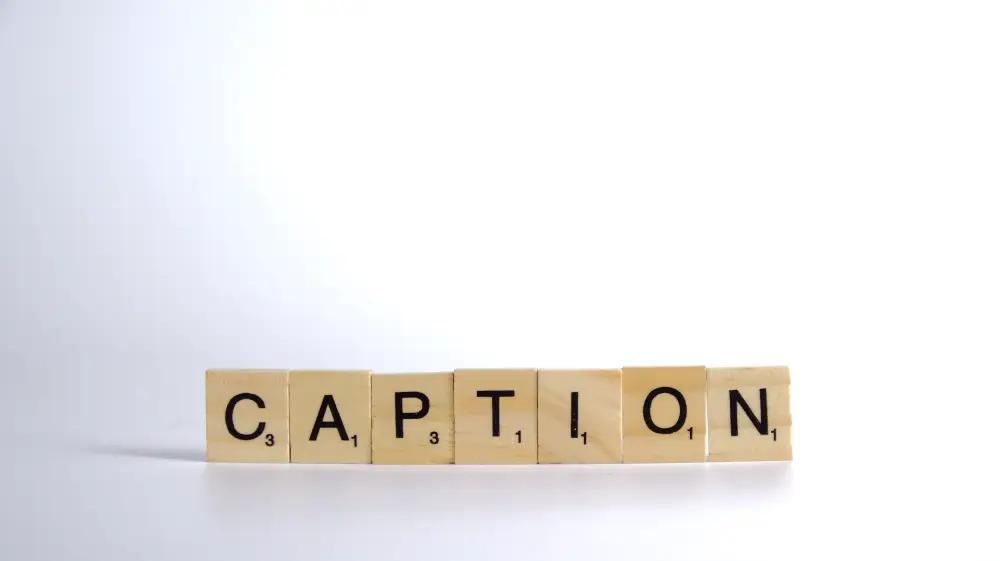Summary
Closed captioning is the process of conveying any audiovisual work into written content that appears at the bottom of the screen, and it includes all background voices. Closed captioning is intended for the deaf and hard of hearing. It can be used in all audiovisual works such as videos and audio, and in all fields as well. Closed captioning can be beneficial for the ones who can hear as well.
Get our subtitling and captions translation now
What is the meaning of captions?
Captions mean the written content of an audiovisual work that appears on the screen. Captions are typically made for the deaf and hard of hearing to be able to follow the audible content that they are unable to hear. Nowadays, it is becoming widely used by nearly everyone since this is the only way that guarantees that audiovisual work reaches everyone, including those who have hearing problems. There are many types of captions.
Nevertheless, to help the ones who can’t hear, there are also subtitles that mean the translation of the audible content from one language into another. Subtitles are also beneficial for the deaf and hard of hearing in case the audible content is in a different language. Both captions and subtitles are beneficial for the deaf and for the hard of hearing.
Get our translation and writing services now
How does live captioning work?
Live captioning means the captions that are performed in real-time and designed for live events. Live captioning allows individuals to have access to audible content at the same time as speaking by having it on screen in a written form. Live captioning happens at the same time as speaking, which means that it isn’t a process that revolves around recorded audiovisual works, but rather, it typically means the live captions that are designed for live events, on the spot. Live captioning can be used in webinars, workshops, and/or training.
What are closed captions?
Closed captions, or CC, typically mean the written form of audiovisual content. Closed captions aim at making it easier for the deaf and hard of hearing to follow the audiovisual content. This is done by including every single detail such as footsteps, clearing throats, giggles, laughs, screams, and all related noises and voices. Closed captions do not only revolve around the simple process of conveying the dialogue into written content, but it also includes all relevant noises and voices that make it easier for the deaf and hard of hearing to follow and to know all that is going on.
However, closed captions might be useful for other reasons, as they can help researchers since they highlight important details such as numbers. Also, closed captions can make the audiovisual content rank on the internet, and it is an easy way to access all the information that is in the audiovisual work. Not to mention that closed captions can be used in all types of audiovisual works such as audios, recordings, videos, movies, series, documentaries, ads, tutorials, podcasts, and more. Also, it is used in all fields, including legal, medical, academic, engineering, psychology, and even in economics and other related fields.
Unravel the Most Frequently Asked Questions about Closed Captioning
What is the difference between live captioning and closed captions?
Live captioning and closed captions have the same purpose, which is to make audiovisual content accessible to everyone, including the deaf and hard of hearing, even for live events. However, there is a difference that must be highlighted. Live captioning isn’t intended for the content that is recorded beforehand, but rather, it is designed for live events and is always performed in real time.
On the other hand, closed captions are done for the audiovisual works that are recorded. Closed captioning is a long, detailed process, while live captioning is designed to be performed in live events and not for recorded videos or audio. Live captioning is for webinars, meetings, seminars, workshops, and even training. As for closed captioning, it can be used for videos, audio, recordings, movies, series, documentaries, and related audiovisual works.
Both live captioning and closed captioning are being used to make it possible for everyone to understand what is being said. They both can be useful for the ones who can hear but are unable to understand certain words which are said in a low voice or that are not being pronounced in the right way. Therefore, live captioning and closed captioning are useful for everyone.
Get our copywriting services now
What is the difference between subtitles and closed captions?
While some use subtitles and closed captions interchangeably, and while they can have a close meaning, there is a slight difference between them.
Subtitles and closed captions both are the written form of an audiovisual work. They both appear at the same time of speaking and they both usually appear at the bottom of the screen.
However, they both have different purposes.
Subtitles are a written form of audiovisual work that is translated from one language into another. Subtitles typically aim at making the audible content understandable for those who don’t understand the source language of the content.
On the other hand, closed captions mean the written form of an audiovisual work in the original language that includes all voices and noises such as giggles, laughs, clearing throats, and other related background noises. Closed captions are intended for the deaf and hard of hearing, as they make it possible for the ones who can’t hear to understand what is being said in the audiovisual work.
Nevertheless, subtitles can be also used as captions in case the audiovisual content is in a language that the deaf and hard of hearing don’t understand. That is why some use the terms closed captions and subtitles interchangeably.
The Difference Between Subtitles and Dubbing
Why closed captioning is important?
Nowadays, closed captioning is so important as the world tends to use audiovisual work and new technologies more as the days go by. Closed captioning has many benefits, including:
Accessible content to the deaf and hard of hearing:
Closed captioning allows everyone to understand what is being said in audiovisual work, even the deaf and hard of hearing. The reason is that it does not only include dialogue, but it also includes background voices and noises that might be important such as giggles, clearing throats, and screams.
Helps people focus:
Even if individuals are able to clearly hear what is going on, closed captions make them focus on what is being said even more. This is very useful in the cases of long videos, and more often than not, individuals might have a hard time following a video or even audio for a long period of time.
Highlights important details:
In so many cases, and for nearly all types and fields, there might be some important details and information that must be highlighted. From numbers to addresses and even amounts, closed captioning can help individuals understand the details and memorize numbers, even if they were said in the background.
Ability to watch in loud and noisy environments:
Closed captioning makes it possible for everyone to watch a video or listen to a voice recording in a noisy environment. This is doable thanks to its ability to include all the dialogue even the background noises and voices. In our hectic world where locations are filled with people or are so noisy, closed captioning can make the whole process of watching or listening much easier.
Easier for researchers:
Having all the dialogue and even background voices and noises written on screen makes it easier to find the audiovisual work. Closed captioning also aims at making it easier for researchers to find the information they are looking for, and they even have the option of reading the information and details instead of closely listening to what is being said. This even helps them identify terms and spellings.
Polishing Your Work: Tips for Editing Your Dissertation
How much does a captioner make?
How much a captioner makes depends on many factors such as the type of audiovisual work, the field, the duration of the work, and the type of captions that is required. Also, some prefer to get paid based on the minute of the audiovisual work while others prefer to get paid based on the time it took them to finish the captioning task. However, on average, captioners can make anywhere between $10 and $75 per hour.
On a side note, captioners for specific fields such as legal, medical, and technical fields, might make more money than captioners for audiovisual works that aren’t as specific. The reason is that is takes them much more time, effort, and research. Also, some might be specialized in a specific field, which makes it even more expensive due to the certificate, the degree, or even the years of experience.
In a nutshell, there is no fixed price, as there are many factors that help in setting a price.
Catchy Captions? A Guide to Different Types of Captioning
Who does closed captioning for youtube?
Closed captioning for YouTube is made by speech-recognition software, if individuals need automatic captions. Captions on YouTube become visible when viewers decide to click a button that is located at the bottom of the video.
How to become a captioner?
While individuals can’t major in captioning, they can make some effort if they wish to become professional captioners. Here are some basic steps to follow:
- Considering certification if one wishes to work as a full-time captioner. The certificate can help individuals learn the basic rules and it even prepares them to work on different types of captioning and for various fields.
- Considering training to be able to gain some experience in the field of captioning.
- Specializing in a specific field. It is not mandatory, but it indeed helps individuals deliver high-quality outcomes. It also helps individuals spend less time in specialized fields.
- Linguistic training or certification is highly recommended. Being a linguist if one wishes to work in the captioning field is an added value that ensures error-free outcomes.
- Developing typing skills to be able to work fast and to boost productivity. This helps individuals work on large projects in no time at all.
- Embracing research since it is very helpful. Research can help individuals write correctly and avoid committing basic mistakes.
- Getting the required captioning equipment such as pedals to be in control of the audiovisual content, captioning software, and noise-cancellation headphones.
- Deciding whether one wants to be a freelancer or to work in a company. This is important because if individuals choose to work in a company, all they have to do is apply, while if they decide to become freelancers, they will need to build connections and attract potential clients.
Get our writing services now
What are the closed captioning rules?
To be able to deliver high-quality captions, there are some rules one needs to stick to, they include:
- Accuracy is the most important rule that one needs to pay close attention to. Captions must be one hundred percent accurate. Also, one must never correct the speakers’ dialogue in terms of grammar for example. Everything must be accurate.
- Attention to the required type of captions and performing work based on the requirements.
- Captions must be delivered synchronously with the dialogue and at the same time speaking to avoid confusion.
- Closed captioning must include all details and information. From background voices and noises to laughs, giggles, clearing throats, and even the way the words are being said (shaky voice for example).
- Never omit or add any information.
- Always proofread after finishing and before delivering the work.
Listen Up: Mastering the Best Way to Transcribe Audio
How to put captions on a video?
It depends on the software, application, or program you are using. However, there is always a button on the screen that is intended for inserting captions. The button is usually on the top right corner of the screen, or at the bottom of the screen. There are even applications that aim at adding captions for all audiovisual works.
Upload your file now and watch it seamlessly transform into any language of your choice!






